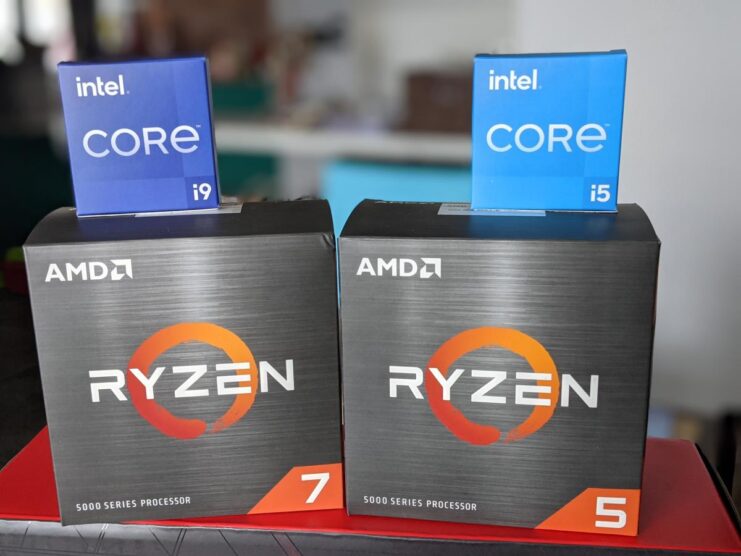Throughout my career, I have seen many changes and innovations in the CPU market over the years. CPUs, or central processing units, are the brains of your PC. They execute the instructions of the software and determine how fast and smooth your PC can run.
There are two main CPU brands in the market: AMD and Intel. Both have been competing for decades, offering a wide range of products for different needs and budgets. But which one is better for your PC?
That is not an easy question to answer, as it depends on several factors, such as your use case, performance expectations, budget, and personal preference. In this article, I will compare AMD and Intel CPUs based on the following criteria:
- Architecture and Technology: How the CPU is designed and manufactured and what features it has to enhance its functionality.
- Performance and Benchmarks: How the processor performs in various scenarios, such as gaming, rendering, and multitasking, and how it compares to its competitors.
- Price and Value: How much the processor costs and what you get for your money, such as cores, cache, and features.
- Compatibility and Upgradeability: How the CPU fits and works with your motherboard, memory, and other components, and how easy it is to upgrade in the future.
- Power Consumption and Cooling: How much power the CPU consumes and how much heat it generates, and what cooling system you need to keep it stable and quiet.
- Features and Extras: What additional functions and capabilities does the CPU offer, such as overclocking, integrated graphics, security, and virtualization.
By the end of this article, you should have a clear idea of which CPU brand is best for your PC. Let’s get started!
Architecture and Technology
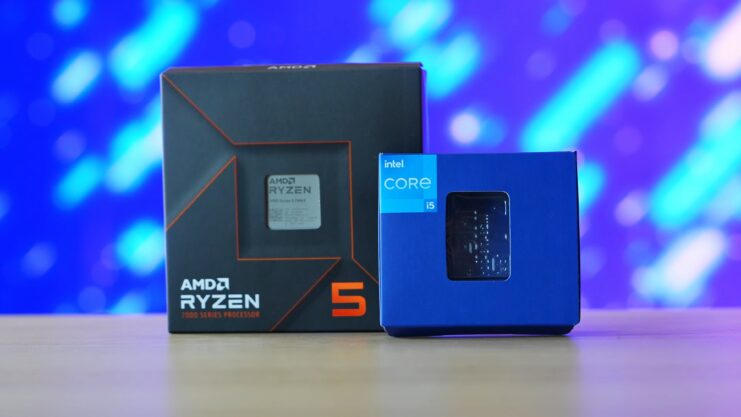
One of the main differences between AMD and Intel processors is the architecture and technology they use. Architecture refers to the design and layout of the CPU components, such as cores, cache, and memory controllers.
Technology refers to the manufacturing process and the features that enhance the CPU functionality, such as instruction sets, security, and overclocking. AMD and Intel have different approaches to architecture and technology. When comparing these two brands nowadays, we generally pay attention to Ryzen 5 vs Intel i5 or Ryzen 7 vs Intel i7.
AMD uses a modular design called chiplet, where multiple small dies are connected together to form a single CPU. Intel uses a monolithic design, where all the CPU components are integrated on a single die.
The advantage of AMD’s chiplet design is that it allows for higher core counts, larger cache sizes, and lower production costs. The disadvantage is that it introduces latency and complexity in the communication between the chiplets and the memory.
Intel’s monolithic design has the opposite pros and cons: it offers lower latency and simpler communication, but it limits the core counts, cache sizes, and production efficiency. Another difference between AMD and Intel is the manufacturing process, which is measured in nanometers (nm).
The smaller the nm, the more transistors can fit on a CPU die, resulting in higher performance and lower power consumption. AMD currently uses a 7nm process for its Ryzen CPUs, while Intel uses a 14nm process for its Core processors.
However, Intel is expected to launch its 10nm Alder Lake CPUs later this year, which will close the gap with AMD. AMD and Intel also have different technologies that enhance their CPUs. For example, AMD has Zen, which is the name of its CPU architecture that has been evolving since 2017.
The latest version is Zen 3, which powers the Ryzen 5000 series CPUs. Zen 3 offers a 19% improvement in instructions per cycle (IPC) over Zen 2, which means it can execute more tasks in less time.
Zen 3 also features a unified L3 cache, which reduces latency and improves performance. Intel has Core, which is the name of its CPU architecture that has been evolving since 2006.
The latest version is Core 10th Gen, which powers the Core i3, i5, i7, and i9 CPUs. Core 10th Gen offers a 10% improvement in IPC over Core 9th Gen, which means it can execute more tasks in less time. Core 10th Gen also features Hyper-Threading, which allows each core to handle two threads simultaneously, increasing the multitasking capability.
Performance and Benchmarks
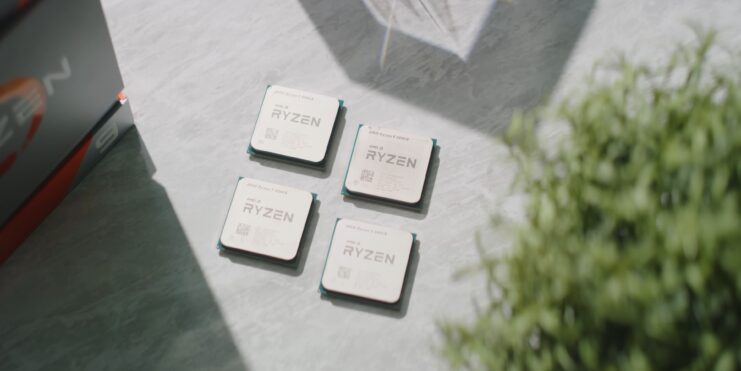
The performance of a processor depends on several factors, such as the core count, clock speed, cache size, memory speed, and workload. The core count is the number of processing units that can handle tasks independently.
The clock speed is the frequency at which the CPU operates, measured in gigahertz (GHz). The cache size is the amount of fast memory that stores frequently used data, measured in megabytes (MB).
The memory speed is the rate at which the CPU accesses the main memory, measured in megahertz (MHz). The workload is the type and complexity of the tasks that the CPU performs, such as gaming, video editing, or web browsing.
The best way to compare the performance of different CPUs is to look at benchmarks, which are standardized tests that measure the CPU performance in various scenarios. There are many benchmarks available, but some of the most popular and reliable ones are Cinebench, Geekbench, PassMark, and UserBenchmark.
These benchmarks test the CPU performance in single-core and multi-core tasks, as well as in different applications, such as rendering, compression, encryption, and gaming. Here are some examples of the benchmark scores of some of the latest AMD and Intel CPUs, based on the average results from UserBenchmark:
| CPU | Single-Core Score | Multi-Core Score |
| AMD Ryzen 9 5950X | 167 | 2,230 |
| AMD Ryzen 9 5900X | 166 | 1,775 |
| AMD Ryzen 7 5800X | 165 | 1,275 |
| AMD Ryzen 5 5600X | 164 | 1,015 |
| Intel Core i9-10900K | 152 | 1,470 |
| Intel Core i7-10700K | 143 | 1,200 |
| Intel Core i5-10600K | 140 | 900 |
| Intel Core i3-10100 | 114 | 500 |
As you can see, AMD has a clear advantage over Intel in single-core and multi-core performance, thanks to its higher IPC, core counts, and cache sizes. However, Intel is still competitive in gaming performance, thanks to its higher clock speeds and lower latency.
Of course, these are just general results, and the actual performance may vary depending on the specific game, settings, and system configuration.
Price and Value
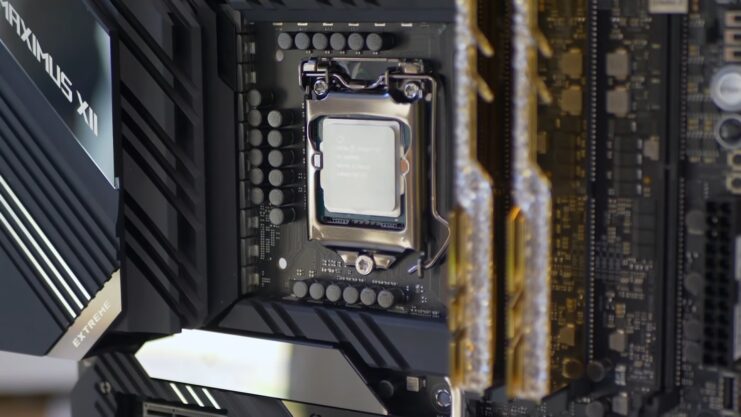
The price of a CPU is another important factor to consider when choosing between AMD and Intel. The price depends on the supply and demand, as well as the features and performance of the processor.
Generally speaking, AMD processors tend to be cheaper than Intel CPUs, but they also offer more cores, cache, and features for the same price range. This means that AMD CPUs tend to offer better value for money than Intel CPUs. Here are some examples of the prices of some of the latest AMD and Intel CPUs, based on the average prices from Amazon:
| CPU | Price |
| AMD Ryzen 9 5950X | $799 |
| AMD Ryzen 9 5900X | $549 |
| AMD Ryzen 7 5800X | $399 |
| AMD Ryzen 5 5600X | $299 |
| Intel Core i9-10900K | $529 |
| Intel Core i7-10700K | $349 |
| Intel Core i5-10600K | $249 |
| Intel Core i3-10100 | $119 |
As you can see, AMD offers more cores and cache for the same or lower price than Intel. For example, the Ryzen 9 5900X has 12 cores and 64 MB of cache, while the Core i9-10900K has 10 cores and 20 MB of cache, but they cost about the same.
Similarly, the Ryzen 5 5600X has 6 cores and 32 MB of cache, while the Core i5-10600K has 6 cores and 12 MB of cache, but the former is cheaper. This means that AMD offers better value for money than Intel, especially for multi-core tasks.
However, price is not the only factor to consider when choosing a CPU. You also have to factor in the cost of the motherboard, the memory, the cooling system, and the power supply. AMD and Intel have different requirements and compatibility for these components, which may affect the overall cost and performance of your PC.
Compatibility and Upgradeability
The compatibility and upgradeability of a CPU depend on the socket and the chipset of the motherboard. The socket is the physical interface that connects the CPU to the motherboard. The chipset is the set of integrated circuits that controls the communication and functionality of the CPU and other components.
AMD and Intel have different sockets and chipsets for their CPUs, which determine the compatibility and upgradeability of the CPU. AMD uses the AM4 socket for its Ryzen CPUs, which has been consistent since the first generation of Ryzen in 2017.
This means that you can use the same motherboard for different generations of Ryzen CPUs as long as you update the BIOS. However, not all AM4 motherboards are compatible with all Ryzen CPUs, as some may have limitations in power delivery, memory support, or features.
AMD also uses different chipsets for its Ryzen CPUs, such as the X570, B550, and A520. These chipsets offer different levels of performance, features, and overclocking support for the Ryzen processors.
Intel uses the LGA 1200 socket for its Core 10th Gen and 11th Gen CPUs, which was introduced in 2020. This means that you cannot use the same motherboard for older generations of Core processors, such as the 9th Gen or 8th Gen.
However, you can use the same motherboard for the 10th Gen and 11th Gen CPUs, as long as you update the BIOS. Intel also uses different chipsets for its Core CPUs, such as the Z590, B560, and H510. These chipsets offer different levels of performance, features, and overclocking support for the Core CPUs.
The advantage of AMD’s socket and chipset compatibility is that it allows for easier and cheaper upgrades, as you can use the same motherboard for multiple generations of Ryzen CPUs.
The disadvantage is that it may limit the performance and features of the newer Ryzen processors, as some older motherboards may not support them fully. The advantage of Intel’s socket and chipset compatibility is that it ensures the optimal performance and features of the Core CPUs, as each generation of Core CPUs has a dedicated socket and chipset. The disadvantage is that it requires more frequent and expensive upgrades, as you have to change the motherboard for each generation of Core CPUs.
Power Consumption and Cooling
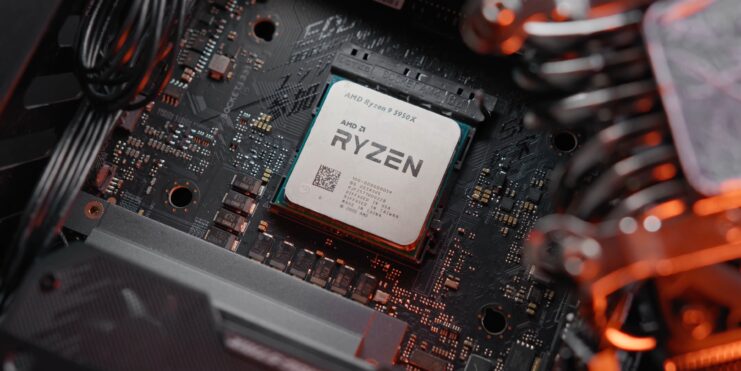
The power consumption and cooling of a CPU depend on the thermal design power (TDP) and the cooling system. The TDP is the amount of heat that the CPU generates under normal operation, measured in watts (W).
The cooling system is the device that dissipates the heat from the processor, such as a fan, a heatsink, or a liquid cooler. AMD and Intel have different TDPs and cooling systems for their CPUs. Generally speaking, AMD CPUs tend to have lower TDPs than Intel processors, but they also tend to run hotter and louder.
This means that AMD CPUs require more efficient and quieter cooling systems than Intel processors. Here are some examples of the TDPs and cooling systems of some of the latest AMD and Intel CPUs:
| CPU | TDP | Cooling System |
| AMD Ryzen 9 5950X | 105 W | Wraith Prism RGB LED Cooler |
| AMD Ryzen 9 5900X | 105 W | Wraith Prism RGB LED Cooler |
| AMD Ryzen 7 5800X | 105 W | No Cooler Included |
| AMD Ryzen 5 5600X | 65 W | Wraith Stealth Cooler |
| Intel Core i9-10900K | 125 W | No Cooler Included |
| Intel Core i7-10700K | 125 W | No Cooler Included |
| Intel Core i5-10600K | 125 W | No Cooler Included |
| Intel Core i3-10100 | 65 W | Stock Cooler |
As you can see, AMD and Intel have similar TDPs for their high-end and low-end CPUs, but AMD includes coolers for most of its CPUs, while Intel does not. However, the coolers that AMD provides are not very effective or quiet, and they may not be enough for overclocking or heavy workloads.
Therefore, you may want to invest in a better cooling system for your AMD processor, especially if you have a Ryzen 7 or Ryzen 9 CPU. Intel, on the other hand, does not include coolers for its CPUs, which means that you have to buy one separately.
However, Intel CPUs tend to run cooler and quieter than AMD CPUs, and they may not need as much cooling as AMD processors. Therefore, you may be able to get away with a cheaper and simpler cooling system for your Intel CPU, especially if you have a Core i3 or Core i5 CPU.
Features and Extras
The features and extras of a CPU are the additional functions and capabilities that the CPU offers, such as overclocking, integrated graphics, security, and virtualization. Overclocking is the process of increasing the clock speed of the CPU beyond its default value, resulting in higher performance but also higher power consumption and heat generation.
Integrated graphics is the feature that allows the CPU to handle graphics processing without a dedicated graphics card, resulting in lower cost but also lower performance. Security is the feature that protects the processor from malicious attacks, such as malware, viruses, and hackers.
Virtualization is the feature that allows the processor to run multiple operating systems or applications simultaneously, resulting in higher efficiency and flexibility. AMD and Intel have different features and extras for their processors.
Generally speaking, AMD processors tend to offer more features and extras than Intel CPUs, but they also tend to have more limitations and drawbacks. This means that AMD CPUs offer more functionality and versatility than Intel CPUs, but they also require more caution and optimization. Here are some examples of the features and extras of some of the latest AMD and Intel CPUs:
| CPU | Overclocking | Integrated Graphics | Security | Virtualization |
| AMD Ryzen 9 5950X | Yes | No | Yes | Yes |
| AMD Ryzen 9 5900X | Yes | No | Yes | Yes |
| AMD Ryzen 7 5800X | Yes | No | Yes | Yes |
| AMD Ryzen 5 5600X | Yes | No | Yes | Yes |
| Intel Core i9-10900K | Yes | Yes | Yes | Yes |
| Intel Core i7-10700K | Yes | Yes | Yes | Yes |
| Intel Core i5-10600K | Yes | Yes | Yes | Yes |
| Intel Core i3-10100 | No | Yes | Yes | Yes |
As you can see, AMD and Intel have similar features and extras for their CPUs, but there are some differences. For example, AMD CPUs support overclocking for all models, while Intel CPUs only support overclocking for the K-series models.
However, AMD CPUs do not have integrated graphics, while Intel processors do. This means that you need a dedicated graphics card for your AMD CPU, while you can use the integrated graphics for your Intel CPU.
Another difference is that AMD processors have more security features than Intel CPUs, such as AMD Secure Processor, AMD Secure Memory Encryption, and AMD Secure Encrypted Virtualization.
These features protect the processor from physical and software attacks, such as cold boot attacks, memory snooping, and hypervisor exploits. However, AMD CPUs also have more security vulnerabilities than Intel processors, such as Spectre, Meltdown, and Fallout. These vulnerabilities expose the CPU to potential data leaks, performance degradation, and system crashes.
FAQs
What is the difference between AMD and Intel CPUs in terms of architecture and technology?
AMD and Intel CPUs use different designs and manufacturing processes for their CPUs. AMD uses a modular design called chiplet, where multiple small dies are connected together to form a single CPU.
Intel uses a monolithic design, where all the CPU components are integrated on a single die. AMD also uses a smaller manufacturing process (7nm) than Intel (14nm or 10nm), which allows for more transistors and lower power consumption. AMD also has a higher IPC (instructions per cycle) than Intel, which means it can execute more tasks in less time.
Which CPU brand is better for gaming performance?
Gaming performance depends on several factors, such as the game, the settings, the resolution, the graphics card, and the system configuration. Generally speaking, Intel CPUs tend to have an edge over AMD CPUs in gaming performance, thanks to their higher clock speeds and lower latency.
However, AMD CPUs are also very capable of gaming, especially with the latest Ryzen 5000 series, which offer a significant improvement in single-core performance. The difference between AMD and Intel CPUs in gaming performance is usually not very noticeable, unless you are playing at very high settings and resolutions.
Which CPU brand offers better value for money?
Value for money depends on your needs and budget. Generally speaking, AMD CPUs tend to offer better value for money than Intel CPUs, as they offer more cores, cache, and features for the same or lower price range.
For example, the Ryzen 9 5900X has 12 cores and 64 MB of cache, while the Core i9-10900K has 10 cores and 20 MB of cache, but they cost about the same. Similarly, the Ryzen 5 5600X has 6 cores and 32 MB of cache, while the Core i5-10600K has 6 cores and 12 MB of cache, but the former is cheaper.
This means that AMD CPUs are more suitable for multi-core tasks, such as rendering, video editing, and streaming.
Which CPU brand is more compatible and upgradeable?
Compatibility and upgradeability depend on the socket and the chipset of the motherboard. AMD processors use the AM4 socket, which has been consistent since the first generation of Ryzen in 2017.
This means that you can use the same motherboard for different generations of Ryzen processors, as long as you update the BIOS. However, not all AM4 motherboards are compatible with all Ryzen processors, as some may have limitations in power delivery, memory support, or features.
Intel processors use the LGA 1200 socket, which was introduced in 2020. This means that you cannot use the same motherboard for older generations of Core CPUs, such as the 9th Gen or 8th Gen. However, you can use the same motherboard for the 10th Gen and 11th Gen CPUs, as long as you update the BIOS.
Which CPU brand consumes more power and generates more heat?
Power consumption and heat generation depend on the TDP (thermal design power) and the cooling system of the processor. AMD and Intel have similar TDPs for their high-end and low-end processors, but AMD includes coolers for most of its processor, while Intel does not.
However, the coolers that AMD provides are not very effective or quiet, and they may not be enough for overclocking or heavy workloads. Therefore, you may want to invest in a better cooling system for your AMD processor, especially if you have a Ryzen 7 or Ryzen 9 CPU.
Intel, on the other hand, does not include coolers for its CPUs, which means that you have to buy one separately. However, Intel processors tend to run cooler and quieter than AMD processors, and they may not need as much cooling as AMD processors.
Which CPU brand has more features and extras?
Features and extras are the additional functions and capabilities that the CPU offers, such as overclocking, integrated graphics, security, and virtualization. AMD and Intel have similar features and extras for their CPUs, but there are some differences.
For example, AMD processors support overclocking for all models, while Intel CPUs only support overclocking for the K-series models. However, AMD processors do not have integrated graphics, while Intel processors do.
This means that you need a dedicated graphics card for your AMD CPU, while you can use the integrated graphics for your Intel processor. Another difference is that AMD CPUs have more security features than Intel processors, such as AMD Secure Processor, AMD Secure Memory Encryption, and AMD Secure Encrypted Virtualization.
However, AMD processors also have more security vulnerabilities than Intel processors, such as Spectre, Meltdown, and Fallout.
The Verdict
AMD and Intel are both excellent CPU brands that offer a wide range of products for different needs and budgets. However, they also have different strengths and weaknesses, which may affect your decision depending on your use case, performance expectations, budget, and personal preference. AMD CPUs are best for:
- Multi-core tasks, such as rendering, video editing, and streaming
- Value for money, as they offer more cores, cache, and features for the same or lower price than Intel processors
- Features and extras, as they offer more security, overclocking, and virtualization capabilities than Intel processors
Intel CPUs are best for:
- Single-core tasks, such as gaming, web browsing, and office work
- Gaming performance, as they offer higher clock speeds and lower latency than AMD CPUs
- Integrated graphics, as they offer graphics processing without a dedicated graphics card
Ultimately, the choice between AMD and Intel is up to you and your preferences. There is no definitive answer to which processor brand is best for your PC, as both have their pros and cons. The best way to decide is to do your own research, compare the specifications and benchmarks, and find the processor that suits your needs and budget.

